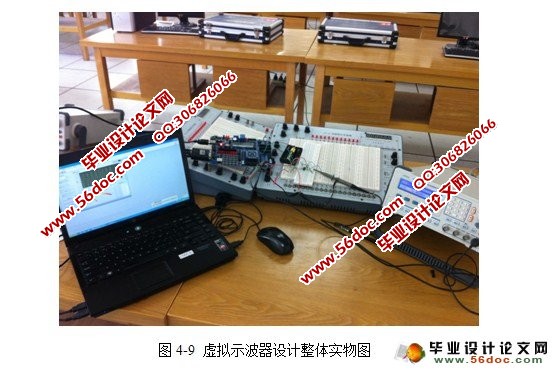基于单片机的虚拟示波器设计
以下是资料介绍,如需要完整的请充值下载. 本资料已审核过,确保内容和网页里介绍一致. 密 惠
无需注册登录,支付后按照提示操作即可获取该资料.
无需注册登录,支付后按照提示操作即可获取该资料.
资料介绍:
摘要
本文主要介绍了MSP430单片机、虚拟示波器的基本结构和工作原理。系统设计主要包括加法电路,A/D模数转换模块,串口通信模块,上位机显示模块等部分。系统采用超低功耗的MSP430单片机为控制芯片,该单片机对输入波形实现模数转换,并且使用RS232与PC机进行串口通信。在PC机端系统以NI公司开发的LabVIEW 8.5为软件开发平台对波形进行分析和再现,可以实现对多种波形的显示,输出的波形稳定不失真,表明系统工作性能较可靠,具有广泛的应用前景。
关键词:虚拟示波器;单片机;模数转换;LabVlEW
Abstract
Virtual instrument technology is the combination of the modern instrument technology and computer technology, is at the forefront of electronic measurement and computer testing and control technology, reflected in the application of simple, flexible, portable, easy to communicate with PC.
This paper mainly introduces MSP430 single chip, the basic structure and working principle of the virtual oscilloscope. System design mainly includes the addition circuit, A/D analog-to-digital conversion module, serial communication module, PC display module, etc. System takes ultra-low power MSP430 single chip microcomputer as control chip.The microcontroller implements analog-to-digital conversion for input waveform modulus, and use the RS232 serial port to communicate with PC. In PC end,system uses LabVIEW 8.5 software which is developed by NI company as development platform for waveform analysis and reappearance, and can be implemented to display a variety of waveform.The output waveform is stable without distortion, showing that system performance is reliable with wide application prospect.
Keywords: virtual oscilloscope; MCU; analog-to-digital conversion; LabVlEW



目录
第一章 绪论 1
1.1 虚拟仪器简介 1
1.2 虚拟仪器的特点及优势 1
1.3 虚拟仪器的发展及应用 3
第二章 芯片介绍 5
2.1 MSP430F149芯片 5
2.1.1 MSP430F149的概述 5
2.1.2 MSP430F149特点 5
2.1.3 MSP430F149的引脚 6
2.2 MSP430F149的模数转换器ADC12 9
2.3 RS232串行通信接口 11
2.3.1串行通信 11
2.3.2 RS一232C标准 11
2.3.3 RS-232常用接口 12
2.4 TL082CN芯片 13
2.5 MAX3232CSE芯片 14
第三章 系统的硬件设计 16
3.1 虚拟示波器的构成及工作原理 16
3.2 硬件功能模块设计 16
3.2.1 加法电路 17
3.2.2 MSP430F149晶振电路设计 18
3.2.3 MSP430F149复位电路设计 18
3.2.4 MSP430F149的A/D转换模块电路设计 19
3.2.5 MSP430F149单片机的串行口电路 20
第四章 系统的软件设计 22
4.1 LABVIEW软件简介 22
4.1.1 LabVIEW特点与应用 22
4.1.2 LabVIEW编程 23
4.2 软件系统总体结构 26
4.3 下位机软件设计 27
4.4 上位机软件设计 28
4.4.1 虚拟示波器前面板设计 28
4.4.2 虚拟示波器后面板设计 28
4.5 系统调试 30
4.5.1 系统实物图 30
4.5.2 系统调试结果 30
结论 33
致谢 34
参考文献 35
附录 36
